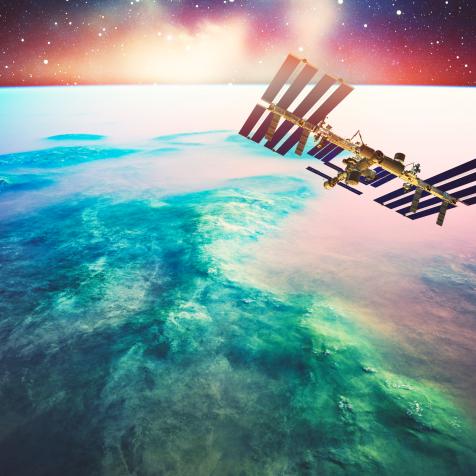
NASA/JPL-Caltech/UCLA
Romeo and Juliet: The Story of Galaxy Collisions

Our Milky Way galaxy is on a collision course. With destiny. With destruction. With fate. With our nearest neighbor, Andromeda.
Over the course of the next 5 billion years, the specter of Andromeda will loom larger and larger on our sky. Right now, it’s nothing but a fuzzy patch of light no bigger than an outstretched fist. But as our galaxies race together at 70 miles per second, that galaxies will grow to engulf our entire night.
And then the fires begin.
There won’t be a single, loud boom or crash. Merging galaxies isn’t anything like crashing cars. Galaxies are mostly empty space – the individual stars make up less than 1% of the volume of any galaxy, with a thin soup of interstellar particles filling out the rest. So its more like two giant swarms of bees encountering each other.
Before the merger proper, our two galaxies will begin to distort, raising tides on each other the same way that the Moon raises tides on the Earth. Giant arms of stars and gas will fling themselves outwards, stretching tens of thousands of lightyears away from each galaxy.

ESA/Hubble & NASA, P. Erwin et al.
The first merger will take about a hundred million years to complete. Our two galaxies will pass through each other, trading gas and dust in the process before swinging away from each other. But like two lovers caught in a fatal embrace, they will return to each others (spiral) arms, again and again.
After about half a billion years, the job will be done.
During the merger itself, our two galaxies will shine like they never have before. Clouds of gas will collide and begin to compress. Shock waves will ripple through the thin interstellar medium. Supernovae will shake and stir the combined galaxies. At its peak, stars will form at a rate ten times higher than it is today.
And then comes the slow, quiet death.

NASA/CXC/Caltech/P.Ogle/JPL
A galaxy about 23 million light years away is the site of impressive, ongoing fireworks. Rather than paper, powder and fire, this galactic light show involves a giant black hole, shock waves and vast reservoirs of gas. This galactic fireworks display is taking place in NGC 4258, also known as M106, a spiral galaxy like our own Milky Way.
All that intense star formation comes at a cost. To form stars to need to compress pockets of gas into small enough volumes. Usually galaxies are very efficient, slowly converting reserves of gas into new stars. But the violence of the collision will ramp this process up, burning through those precious reserves in a relative blink of an eye.
Without the merger, our two galaxies could keep forming stars for trillions of years to come. But after their final embrace, there won’t be any new material left to keep the fires lit.
The most massive stars will die first in a fury of supernova bursts. Then the medium, sun-like stars will turn themselves inside out, forming red giants, planetary nebulae, and white dwarfs. All that will remain will be the small, dim, long-lived dwarf stars, left to rule over the ruined husk of the newly-merged galaxy.
It will be beautiful…while it lasts.
Dive Deeper into the Cosmos
Journey Through the Cosmos in an All-New Season of How the Universe Works
The new season premieres March 24 on Science Channel and streams on discovery+.




















